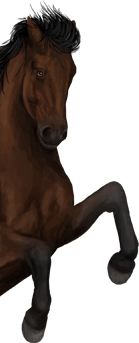This blog post was written by: HolyCow
In
the previous blog, I briefly explained Mendelian inheritance. This involved one dominant and one recessive gene each, which because they were on separate chromosomes were passed on independently of each other, each gene having its own effect.
In reality, there are many genes on a chromosome, so many genes are not passed on independently of each other, ‘recessive and dominant’ are often a bit more nuanced, many genes have multiple alleles, and sometimes you need several genes before you will be able to see something of them in the phenotype.
Multiple Allelism
First, I will cover multiple allelism. So within a gene, multiple gene variants/alleles are possible. For example, on MH you have the coat colours Seal Brown, Bay, Light Bay and Black. This system is based on an unproven theory about how different colours of bay (Seal Brown, Bay and Wild Bay) might work in real life.
With multiple alleles for a gene, you cannot always simply say anymore, one is dominant and the other is recessive. However, there can still be dominance between the different genevariants. After all, dark bay is dominant over bay, seal brown and black, but bay is in turn dominant over seal brown and black, with seal brown only being dominant over black and black being recessive to all the other variants.
The notation of alleles in multiple genes often follows a mixture of the superscript and loose letters.
The type of bay (or black) coat is decided by the gene ASIP/Agouti, so for this you use the letter A. On MH it is often referred to as:
- 'A' for dark bay,
- 'A+' for bay (Bay is the equivalent of 'Light Bay' on the Dutch server, which was based on Wild Bay, which was thought to be the original type of bay),
- 'At' for seal brown (the t standing for the 'tan' points),
- 'a' for black or 'no-agouti'
However, because of the multiple allelism, these could also be written like: A (dark bay) - a+ (bay) - at (seal brown) - a (black). Which could even be considered more correct, since in the case of multiple alleles, often only the top dominant allele, in this case 'A', and Co-dominant alleles, would be given an upper case letter, with all the other alleles getting lowercase letters.
Using 'A' for dark bay, a for black, 'a^+' for (wild) bay, and 'a^t' for seal brown, would also be correct.

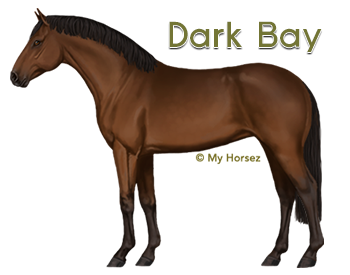
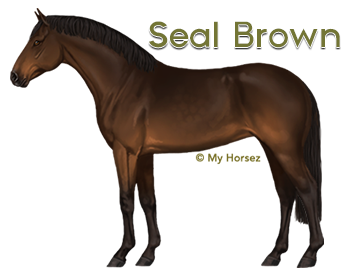
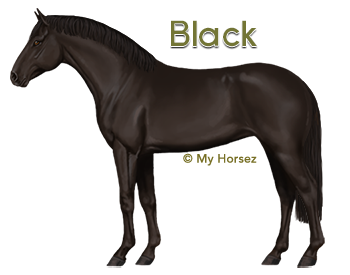
Incomplete Dominance and co-dominance
It can also happen that one genevariant is not really dominant over the other. Imagine there being to possible alleles on gene X: 1, and 2. In this case, a homozygote of allele 1, heterozygote, and homozygote of allele 2, all have different phenotypes. Of these 'one is not dominant over the other' kinda situations, you have 2 types: Incomplete dominant and Co-dominant.
Incomplete dominant involves a mixture of both phenotypes. From this, a blended form of both phenotypes arises.
A well-known example in horses is the cream gene. Suppose you have a horse with a chestnut base. When they are homozygous for the wildtype 'no-cream' alleles, they will be a chestnut. Are they homozygous for the cream allele then they'll have a very light cream-coloured coat. However: When heterozygous they'll have a coat in between: palomino (yellowish-light brown).
Like I said earlier, besides Incomplete Dominance there is also something called Co-dominant. When this is the case, both alleles are visible on their own when present, instead of blended. A well-known example to distinguish between incomplete dominant and co-dominant are flowers. One allele is white, the other is red. In the case of incomplete dominance, the red and white blend together into a pink flower. However, with co-dominance, you get a flower with both red and white parts.
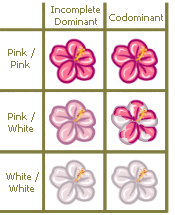 This image shows the difference between Co-Dominance and Incomplete Dominance. In this case, there are two alleles: One causing a dark pink colour, and one causing a white colour.
This image shows the difference between Co-Dominance and Incomplete Dominance. In this case, there are two alleles: One causing a dark pink colour, and one causing a white colour.
Dominant and Recessive Epistasis
Besides interaction of alleles with each other, other genes at different loci may also interact with each other. They can cause the effects of certain genes to not be visible in the phenotype anymore, regardless of which alleles are present. This is when
epistasis occurs.
You may have noticed that in this and previous blogs, in both the examples of Base coats and Bay coats, the coat colour ‘black’ appears. This is because the genes MC1R/Extension/basic colour (chestnut/black) and ASIP/Agouti (brown/black) determine which (base) coat colour a horse gets.
Suppose a horse has a dark bay allele (AA or Aa). It then depends on the alleles of the base colour whether a horse actually gets that bay coat colour.
On a horse whose coat colour based solely on the 'Base colour'-gene is black (meaning they're either EE or Ee), the effects of the agouti gene will be visible: For example, Dark Bay with the 'A' allele, and black with the 'a' allele.
On a horse who will be chestnut based on their 'Base colour'-gene (ee), it does not matter whether the agouti gene is A, a, A+, or At. It will not be visible On a chestnut-based horse, this will only be if the 'Base Colour'-gene has a 'EE' genotype.
In this case, chestnut is the recessive allele of the Base Colour gene, meaning this is an example of
recessive epistasis. We can say the chestnut-allele is (recessive) epistatic over agouti. Vice versa, agouti is
hypostatic for chestnut.
Dominant epistasis also exists. This is the case when the epistatic allele is dominant. An example in horses would be Grey (G). Grey, when a horse ends up all white in colour with a dark skin, is epistatic over many coat colours, thus including the Base Colour and Agouti genes. Whether a horse is EE/Aa, ee/AA, Ee/AAt doesn't matter. Wait long enough, and at one point you can't tell the difference anymore by just looking at the horse.
Polygenetics and pleiotropy
Another way different genes affect each other is through polygenism.
In polygenetics, genes work together, so to speak, to arrive at a particular phenotype. A clear example in horses are the appaloosa genes.
Here, on one gene you have the Lp allele that ensures that there are appaloosa characteristics at all and how strong these characteristics can present. Then there are several PATN (pattern) genes that determine which of the possible patterns comes out. Varnish, Leopard/Few Spot, or Blanket/Snowcap?
The other way around, pleiotropy is another thing that exists. This is when one gene influences several traits. In colour genetics, this unfortunately often involves hereditary diseases associated with that colour. Take the Frame Overo gene for example: besides the fact that it is apparently important for pigment cells, as shown with the unique Frame Overo pattern in heterozygous horses and white colour in homozygous foals, it is also important for the development of nerve cells the intestinal system: horses homozygous for the Frame Overo allele get Lethal White Syndrome, in which the foal's intestinal system does not function properly, and the foal eventually dies.
This was it for today! Hopefully you were able to understand this and learned something from it. Next time I’ll talk about non-mendelian inheritance on a chromosomal level, instead of on gene / allelic levels!
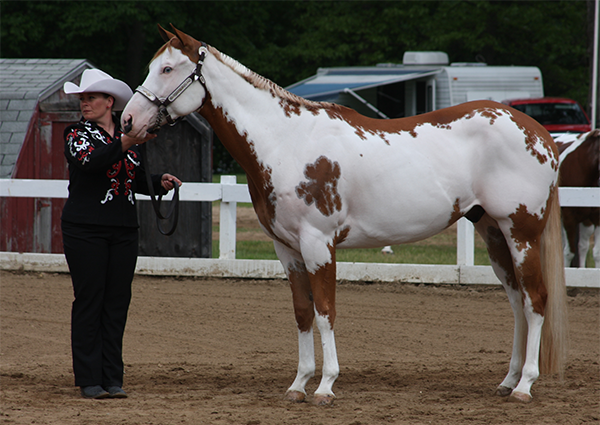 Recessive epistatis and pleitropy in one picture!
Recessive epistatis and pleitropy in one picture!
Source: Sandysphotos2009, via Wikimedia Commons
Need to refresh your memory or gain some more knowledge? Read the previous blogs about genetics
•
Horse Genetics #1: Back to the Basics 1.0
•
Horse Genetics #2: Back to the Basics 2.0








